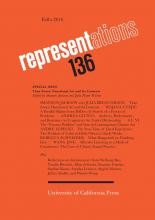by Shannon Jackson and Julia Bryan-Wilson
This introduction to the Time Zones special issue begins:
Do we have a problem with time? The we here is specific—it means not only the scholars, curators, and practitioners who think critically about twentieth- and twenty-first-century artistic production and its relationship to temporality but also the small collective of the two of us who are writing this introduction together. We are a performance studies scholar and an art historian who have been thinking together about what makes questions about time so persistent, and so vexed, within and between our two fields. Duration, we have come to realize, might be the conceptual connective tissue that links these two increasingly overlapping disciplines. But “durational art” is only one of the many names that have proliferated in an attempt to bound an unboundable set of practices that frequently violate the borders of medium-specificity as they move from so-called “static” configurations into durational forms: time-based art, live art, hybrid art, intermedial art.
What happens when the same phrases—“durational art” or “time-based art”—traffic back and forth between the traditional visual arts (painting, sculpture) and the performing arts, especially when, in the performance-based disciplines, time or liveness hardly feels “new”? While the history of twentieth- and twenty-first-century artistic experimentation is one of ever more blurry disciplinary borders, we often find that the habits and divisions of labor within different art institutions persist. Moreover, the training of artists and of critics separates skills and evaluative barometers within different art fields. Many kinds of cultural producers may be making, curating, and evaluating “live” art work, but our sense of what kind of work it is will be different depending upon its context, whether it is housed in a museum or a theater, or whether it is analyzed by a dance critic, a film critic, or a critic of visual arts.
Time Zones: Durational Art and Its Contexts brings together six substantial essays (by Bojana Cvejić, Andrea Giunta, Yi Gu, André Lepecki, Rebecca Schneider, and Wang Jing) and nine shorter reflections (by Weihong Bao, Natalia Brizuela, Allan deSouza, Suzanne Guerlac, SanSan Kwan, Anneka Lenssen, Jeffrey Skoller, and Winnie Wong) that approach time, duration, and liveness from an array of disciplinary and regional contexts. From the affective registers of contemporary sound art in China to the politics of labor and laziness in a collaborative performance collective in Zagreb to archive-based interventions during the Uruguay military dictatorship of the 1970s and 1980s, the essays plumb the specificities of practices as they unfold in real times and physical spaces. Contributors consider how the presumed presentism of “live art” puts pressure on the demands of historicity, as well as how it reconfigures relations to art’s viewers or witnesses. The essays and reflections examine how notions of time and duration have emerged as central, yet contested, in diverse projects that include public art, kinetic body-based sculpture, dance, and photography.
Together these texts make an argument, which is that the contexts that frame durational art—whether rhetorical, or national, or institutional—matter a great deal. Where and when does a piece take place? In what kind of site is it situated, and in what moment of time does it occur? What are the conditions of its inception and its continued circulation? Who is in the audience, and who talks about it after the fact? Is it applauded, or is it censored? These experiments with time respond to the local economic politics of particular regions as well as to transnational circuits of exchange. Questions of time in art interact with larger questions of migration, capitalism, and mobility in a global world. The ephemeral quality of time-based art can address and elude the political urgencies of volatile sites. Regionally specific themes and political issues prompt artists to collaborate across disciplines in some contexts but dissuade them in others. Funding models in different regions of the world both support and limit the capacity of artists to work across disciplines. Time-based art can in some cases disrupt and in others activate the demands of a market-based art calendar packed with biennials and high-profile festivals. It both challenges and enables the consumptive models of a globalized art world. Continue reading (free access for a limited time) …
Exploring the emergence of the rubric “time-based art” across several disciplinary formations, including performance and visual art, this editors’ introduction outlines some historical theories of duration across the arts and argues for a contextual approach that accounts for both medium and institutional location.
SHANNON JACKSON is Hadidi Chair in the Humanities at the University of California, Berkeley, where she is Professor of Rhetoric and of Theater, Dance, and Performance Studies, as well as Director of the Arts Research Center. Other publications include The Builders Association (2015), Social Works (2011), Professing Performance (2004), and the forthcoming online anthology of keywords, In Terms of Performance, co-edited with Paula Marincola and the Pew Center for Arts & Heritage.
JULIA BRYAN-WILSON is Associate Professor of Modern and Contemporary Art in the Department of History of Art at the University of California, Berkeley. She is the author of Art Workers: Radical Practice in the Vietnam War Era (2009), Art in the Making: Artists and Their Materials from the Studio to Crowdsourcing (2016), and Fray: Art and Textile Politics, forthcoming from the University of Chicago Press.

